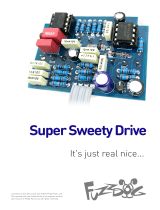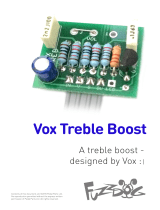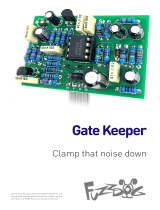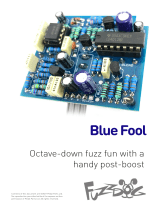FuzzDog P45 Phaser Operating instructions
- Type
- Operating instructions

Phase 45
Swooshy goodness with
some interesting mods
Contents of this document are ©2016 Pedal Parts Ltd.
No reproduction permitted without the express written
permission of Pedal Parts Ltd. All rights reserved.

Schematic
+ BOM
R1 10K
R2 10K
R3 20K
R4 10K
R5 10K
R6 10K
R7 10K
R8 10K
R9 10K
R10 150K
R11 470K
R12 10K
R13 10K
R14 10K
R15 470K
R16 10K
R17 470K
R18 1M
R19 3M9
R20 150K
R21 150K
R22 7K5
R23 2K2
R24 150K
R25 150K
R26 10K
C1 10n
C2 47n
C3 10n
C4 47n
C5 100n
C6 47n
C7 10n
C8 10n
C9 47n
C10 10u
C11 10n
C12 10u
C13 10u
Q1,2 Matched FETS*
(2N5457, 2N5952 etc)
D1 1N4001
D2 5.1v zener
IC1,2 TL072
MIX 20KB**
SPEED 500KC***
BIAS 220-500K Trim
or pot‡
SW1 DPDT ON-ON‡‡
*Watch your pinouts. The PCB is designed for 2N5457 but
other FETs may need rotating, such as 2N5952.
**Optional. If you’re using a MIX pot then leave out R8-9.
***500KB will do but the sweep is better with reverse log.
‡ A 250KB pot is recommended if you want external bias.
‡‡ Optional UniVibe mode switch. You need to place a
couple of jumpers if not doing this mod. See later in doc.

The power and signal pads on the PCB
conform to the FuzzDog Direct Connection
format, so can be paired with the appropriate
daughterboard for quick and easy offboard
wiring. Check the separate daughterboard
document for details.
Be very careful when soldering the diodes and
transistors. They’re very sensitive to heat. You
should use some kind of heat sink (crocodile
clip or reverse action tweezers) on each leg as
you solder them. Keep exposure to heat to a
minimum (under 2 seconds). Sockets are
recommended for the ICs.
Snap the small metal tag off the pots so they
can be mounted flush in the box.
You should solder all other board-mounted
components before you solder the pots. Once
they’re in place you’ll have no access to much
of the board. Make sure your pots all line up
nicely. The best way to do that is to solder a
single pin of each pot in place then melt and
adjust if necessary before soldering in the
other two pins. If your pots don’t have
protective plastic jackets ensure you leave a
decent gap between the pot body and the PCB
otherwise you risk shorting out the circuit.
Same goes for the toggle switch. Use your
enclosure as a guide for positioning them to
ensure they line up properly. Solder one lug,
then melt it and adjust to get it straight before
soldering any others.
Positive (anode) legs of the electrolytic caps
go to the square pads.
Negative (cathode) legs of the diodes go to the
square pads.
PCB layout ©2016 Pedal Parts Ltd.

MODS
External Bias
Simply use a pot instead of the trimmer for
the BIAS control. 250KB is best. To be honest
this is best left as an internal trimmer, as
there’s a small range in which the circuit will
perform well.
UniVibe-ish Mode
By replacing a pair of matched caps with
different values you can get a decent
approximation of a UniVibe. It’s no match for
the real thing, but an interesting effect
nonetheless.
C3 and C5 are the extra caps. If you aren’t
doing this mod, leave them out. If you’ve
already put them in because you don’t read
the whole doc before building, no matter.
They’ll have no effect unless you add the
switch.
If you aren’t adding this switch you should
place jumpers across the switch pads shown.
Flashing Rate LED
The LED pad on the main PCB will give you a
voltage that matches the rate of the effect.
You can add an always-on indicator by wiring
up an LED to this pad and any ground point.
If you want your bypass indicator LED to flash
you should use this pad to send power to the
footswitch daughterboard. Leave the Current
Limiting Resistor off the daughterboard and
take a wire from the LED pad of the main PCB
to the point shown.
Mix Control
By altering the amount of phased signal in the
mix you can get a wide range of sounds, from
phasing to a kind of pitch-shifted vibrato.
Use a 20KB pot and leave out R8 and R9.

Test the board!
UNDER NO CIRCUMSTANCES will troubleshooting help
be offered if you have skipped this stage. No exceptions.
Once you’ve finished the circuit it makes sense to test is before starting on the switch and
LED wiring. It’ll cut down troubleshooting time in the long run. If the circuit works at this
stage, but it doesn’t once you wire up the switch - guess what? You’ve probably made a
mistake with the switch.
Solder some nice, long lengths of wire to the board connections for 9V, GND, IN and OUT.
Connect IN and OUT to the jacks as shown. Connect all the GNDs together (twist them up
and add a small amount of solder to tack it). Connect the battery + lead to the 9V wire,
same method. Plug in. Go!
If it works, crack on and do your switch wiring. If not... aw man. At least you know the
problem is with the circuit. Find out why, get it working, THEN worry about the switch etc.
BATTERY
IN OUT
Your nice, new circuit board
INCLUDING WIRED POTS!!!!
IN 9V GND OUT

Wiring shown above will disconnect the battery when you remove the jack plug
from the input, and also when a DC plug is inserted.
The Board GND connections don’t all have to directly attach to the board. You
can run a couple of wires from the DC connector, one to the board, another to
the IN jack, then daisy chain that over to the OUT jack.
It doesn’t matter how they all connect, as long as they do.
This circuit is standard, Negative GND. Your power supply should be Tip
Negative / Sleeve Positive. That’s the same as your standard pedals (Boss etc),
and you can safely daisy-chain your supply to this pedal.
L
E
D
BOARD
OUT
BOARD
9V
BOARD
GND
BOARD
GND
BOARD
GND
BOARD
INPUT
BATTERY
+
IN
OUT
L
E
D
BOARD
GND
BOARD
LED+
+
Wire it up (if using a daughterboard please refer to the relevant document)

This template is a rough guide only. You should ensure correct marking of your
enclosure before drilling. You use this template at your own risk.
Pedal Parts Ltd can accept no responsibility for incorrect drilling of enclosures.
FuzzDog.co.uk
Drilling template
Hammond 1590B
60 x 111 x 31mm
It’s a good idea to drill the pot and
toggle switch holes 1mm bigger if
you’re board-mounting them.
Wiggle room = good!
Recommended drill sizes:
Pots 7mm
Jacks 10mm
Footswitch 12mm
DC Socket 12mm
Toggle switch 6mm
32mm
27mm
20mm
-
 1
1
-
 2
2
-
 3
3
-
 4
4
-
 5
5
-
 6
6
-
 7
7
FuzzDog P45 Phaser Operating instructions
- Type
- Operating instructions
Ask a question and I''ll find the answer in the document
Finding information in a document is now easier with AI
Related papers
-
 FuzzDog Super Sweety Drive Operating instructions
FuzzDog Super Sweety Drive Operating instructions
-
 FuzzDog Vox Treble Boost Operating instructions
FuzzDog Vox Treble Boost Operating instructions
-
 FuzzDog Eight Two Zero Drive Operating instructions
FuzzDog Eight Two Zero Drive Operating instructions
-
 FuzzDog Thug Fuzz Operating instructions
FuzzDog Thug Fuzz Operating instructions
-
 FuzzDog Gate Keeper Noise Gate Operating instructions
FuzzDog Gate Keeper Noise Gate Operating instructions
-
 FuzzDog RunOffGroove THOR Operating instructions
FuzzDog RunOffGroove THOR Operating instructions
-
 FuzzDog Cherub Chorus Operating instructions
FuzzDog Cherub Chorus Operating instructions
-
 FuzzDog Sonic Tight'un Distortion Operating instructions
FuzzDog Sonic Tight'un Distortion Operating instructions
-
 FuzzDog Blue Fool - MXR Blue Box+ Operating instructions
FuzzDog Blue Fool - MXR Blue Box+ Operating instructions
-
 FuzzDog Sacred Utterance Overdrive Operating instructions
FuzzDog Sacred Utterance Overdrive Operating instructions
















